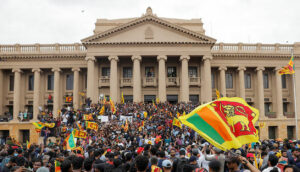The Philippine National Railways in the supply chain equation

A press report stated that Ferdinand Marcos, Jr. would take over the Department of Agriculture (DA) upon his assumption of the Presidency today. The major reason cited for this extraordinary step is the food crisis and the need to unclog the supply chain that starts with food and crops being produced at the farms and ends with consumption. That description of the supply chain would be in its simplest terms. The chain is, however, as strong as its weakest link. Production, an integral part of the supply chain, has its own sub-supply chain if one were to consider the planting materials or seeds that have to be transported to or grown within the farm, the fertilizer and pesticide to be used to maintain and protect the crop, the water to be pumped into the field from irrigation systems, the farm implements and machinery, the credit used for working capital and so on and on until the product is ready for harvest, for processing, and eventually to become part of another supply chain.
Though simplistic, the above sequence clearly reveals a lot of logistical issues and the physical movement of labor, raw materials, and other factors of production. And movement means transportation, often motorized, for efficiency, cost effectiveness, and speed. Transportation, as an integral part of the supply chain, is therefore essential to any economy. Marcos Jr. wants to focus on making the supply chain more efficient as he tries to grapple with the food crisis created by both domestic and global factors and events.
Studies have shown the tremendous impact of an inefficient and pollutive transport system.
Metro Manila contributes about 35% to national Gross Domestic Product (GDP); and Mega Manila — Metro Manila plus Central Luzon, Calabarzon (Cavite, Laguna, Batangas, Rizal and Quezon), and Mimaropa (Mindoro Island, Marinduque, Romblon and Palawan) — accounts for 55% of GDP. The Japan International Cooperation Agency (JICA) states that an inefficient transport system costs these regional economic groupings about P3.5 billion a day due to traffic congestion. The cost of air pollution directly attributable to traffic jams and gridlock is about P7.5 billion a day according to the Institute for Climate and Sustainable Cities.
While traffic management is a key priority, keeping the roads safe and traffic moving and providing for commuters’ needs without overburdening the transport network, is a different issue from transportation as pointed out by Department of Transportation (DoTr) planners. They emphasize that transportation is the mandate of the DoTr in coordination with the Department of Public Works and Highways (DPWH) while traffic management is the mandate of the Metro Manila Development Authority (MMDA) and Local Government Units (LGUs) outside of the MMDA jurisdiction.
Both DoTr and DPWH are, however, crucial to influencing the supply chain and food production and distribution. Food security and sufficiency are problems that the Agriculture department cannot solve by its lonesome. Just like all major impactful issues, a coordinated and synchronized multi-disciplinary/inter departmental approach is required. How can farmers produce at optimal cost if the transport costs of inputs are prohibitive because there are no transport systems plying their farm areas due, in turn, to the absence of farm-to-market roads and major highway or rail systems as outlets? How can they be provided with production credit if the rural banking system in one’s area is almost non-existent?
One can go on and belabor the point about the importance of the transportation sector in the daily lives of both urban dwellers and our huge farming and agriculture sector. As various solutions are being proposed, those knowledgeable with the important details of the preparatory planning work point out the fact that the transport sector may have minimized the importance and significance of transportation planning that is inter operative and multi-modal as advocated by Senator Grace Poe, among others, as early as 2016.
The insufficient attention given to planning and project development surfaces in several ways, most notably in the railway system represented basically by the Philippine National Railways (PNR).
Memories are still fresh about the PNR during our Boy Scout days at De La Salle Grade School in 1957. We belonged to Troop 224 and we looked forward to camping trips headed by our Scoutmaster or Troop Leader in Grade 4, Mr. Jacinto. My parents would bring me to Tutuban railroad station at almost midnight to join about 30 other scouts to camp at the then Christian Brothers house in Baguio for two nights. The PNR train would arrive at Damortis, La Union at around six in the morning and we would then proceed to Baguio on board a Bangeute Auto Line (BAL) bus via Naguilian road.
Sixty-five years ago, the PNR could go as far north as La Union. Now, PNR’s only operating line destination from Tutuban is Calamba, Laguna. That’s a mere 100 kilometers which pales in comparison to the distance between Tutuban and Damortis. The PNR simply became moribund in the early 1980s, supposedly the golden years of Martial Law. Reviving it should be one of the priorities of Secretary-designate Jaime Bautista.
Why did a key transportation mode — the railroad train — fall into disuse and even disrepute? It had by then suffered from an image problem: that it was dirty, unreliable, dangerous.
One suspects again that there was a failure to really develop projects, prepare feasibility studies, and a lack of overall project management. It was not uncommon to hear of the lack of project roll out even after a successful bidding. We understand that about P3 trillion has been made available to extend the PNR north up to Clark via Malolos and south up to Calamba and Legazpi, Albay.
What is even more frustrating is that the lands for these routes are all owned by PNR and are therefore not bogged down by Rights of Way (ROW) issues. In short, these are low lying fruit waiting to be picked. And these are but two or three of many projects.
The PNR already has a lot on its portfolio, but between 2022 to 2028, there is a need to level up by including in its portfolio all the needed studies and designs with which railway experts are familiar.
We have heard of plans for a North-South Mindanao Rail Line (Butuan, Agusan del Norte to Davao Seaport and Airport) which is a commuter and cargo rail line. Well and good, let the experts do the plans and execute it.
Any extension of any transport mode is akin to opening up virgin territory without the corresponding massive land development at the outset. Any extension will enhance the all-important supply chain channel between several points. In this case, it will facilitate the travel channel between Northern and Southern Mindanao and also create new tourist destination points in other parts of the country which are tourist-commuter friendly.
The challenge is there to revive the railway system and make the supply chain more efficient and cost-effective. Let’s go back up to Damortis again, and even farther. Jimmy Bautista has his work cut out for him even as he attends to land, air, and sea transport.
Philip Ella Juico’s areas of interest include the protection and promotion of democracy, free markets, sustainable development, social responsibility and sports as a tool for social development. He obtained his doctorate in business at De La Salle University. Dr. Juico served as secretary of Agrarian Reform during the Corazon C. Aquino administration.




